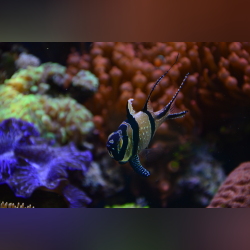Info
Pseudojuloides severnsi Bellwood & Randall, 2000
Males have a blue, red or magenta line along the upper jaw that extends over the eyes and abruptly separates the dark rear half of the head and front body from the whitish lower half. Males also have a turquoise dorsal fin with a broad orange submarginal band, bright yellow sides with turquoise stripes, and a blue caudal fin with blue and black upper and lower lobes.
Females are pink and turn whitish on the underside, with an orange upper head. Juveniles have a white mouth tip.
Jumping guard
A jumping guard prevents (nocturnal) fish from jumping out.
Wrasses, blennies, hawkfishs and gobies jump out of an unprotected tank in fright if their night rest is disturbed, unfortunately these jumpers are found dried up in the morning on carpets, glass edges or later behind the tank.
https://www.korallenriff.de/en/article/1925_5_Jump_Protection_Solutions_for_Fish_in_the_Aquarium__5_Net_Covers.html
A small night light also helps, as it provides the fish with a means of orientation in the dark!
Males have a blue, red or magenta line along the upper jaw that extends over the eyes and abruptly separates the dark rear half of the head and front body from the whitish lower half. Males also have a turquoise dorsal fin with a broad orange submarginal band, bright yellow sides with turquoise stripes, and a blue caudal fin with blue and black upper and lower lobes.
Females are pink and turn whitish on the underside, with an orange upper head. Juveniles have a white mouth tip.
Jumping guard
A jumping guard prevents (nocturnal) fish from jumping out.
Wrasses, blennies, hawkfishs and gobies jump out of an unprotected tank in fright if their night rest is disturbed, unfortunately these jumpers are found dried up in the morning on carpets, glass edges or later behind the tank.
https://www.korallenriff.de/en/article/1925_5_Jump_Protection_Solutions_for_Fish_in_the_Aquarium__5_Net_Covers.html
A small night light also helps, as it provides the fish with a means of orientation in the dark!







 Lemon Tea Yi Kai, Japan
Lemon Tea Yi Kai, Japan




























